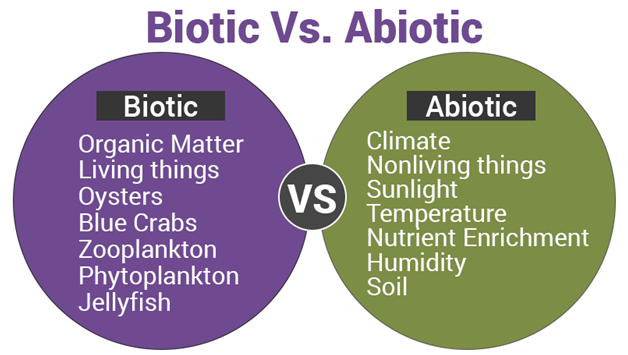Is Dirt Biotic Or Abiotic
Table of Contents
- Biotic
- Abiotic
- Difference between Biotic and Abiotic
Biotic and abiotic are the ii essential factors responsible for shaping the ecosystem. The biotic factors refer to all the living beings present in an ecosystem, and the abiotic factors refer to all the non-living components like physical atmospheric condition (temperature, pH, humidity, salinity, sunlight, etc.) and chemical agents (different gases and mineral nutrients present in the air, water, soil, etc.) in an ecosystem. Therefore, both the abiotic and biotic resources bear on the survival and reproduction process.
Furthermore, both these components are reliant on each other. Suppose if one of the factors is removed or contradistinct, its repercussions volition be faced past the entire ecosystem. Without a incertitude, abiotic factors directly touch the survival of organisms. Read on to explore what role practise abiotic and biotic resources play in the ecosystem.
Likewise read: Ecosystem

Biotic Significant
The term "biotic" is formed by the combination of two terms, "bio"meaning life and"ic"significant like. Thus, the term means life-similar and is related to all the living entities present in an ecosystem.
Biotic Factors
Biotic factors relate to all the living things in the ecosystem. Their presence and their biological by-products impact the limerick of an ecosystem. Biotic factors refer to all living organisms from animals and humans, to plants, fungi, and bacteria. The interactions between diverse biotic factors are necessary for the reproduction of each species and to fulfil essential requirements like food, etc.
Examples of Biotic Factors
Examples of biotic resources include all the living components present in an ecosystem. These include producers, consumers, decomposers and detritivores.
Abiotic Meaning
The term abiotic refers to all the non-living factors present in an ecosystem. Sunlight, water and land, all constitute the abiotic factors.
Abiotic Factors
Abiotic factors refer to all the not-living, i.e. chemical and physical factors nowadays in the atmosphere, hydrosphere, and lithosphere. Sunlight, air, precipitation, minerals, and soil are some examples of abiotic factors. These factors have a meaning impact on the survival and reproduction of species in an ecosystem.
For instance, without an adequate amount of sunlight, autotrophic organisms may not exist able to survive. When these organisms eventually dice, it will create a shortage of food for primary consumers. This effect cascades upward the nutrient concatenation, affecting every organism. Consequently, information technology leads to an imbalance in the ecosystem.
Examples of Abiotic Factors
Abiotic examples typically depend on the type of ecosystem. For instance, abiotic components in a terrestrial ecosystem include air, weather, water, temperature, humidity, altitude, the pH level of soil, type of soil and more. Abiotic examples in an aquatic ecosystem include water salinity, oxygen levels, pH levels, water menses rate, water depth and temperature.
At present, let'southward accept a await at the meaning deviation betwixt the abiotic and biotic factors.
Recommended Video:

Deviation betwixt Biotic and Abiotic Factors
Following are the important departure between abiotic and biotic factors:
| Divergence Between Biotic Resources and Abiotic Resources | |
| Biotic Resources | Abiotic Resource |
| Definition | |
| Biotic factors include all the living components present in an ecosystem | Abiotic factors refer to all the non-living, i.e. physical conditions and chemical factors that influence an ecosystem |
| Examples | |
| Examples of biotic resource include all flora and fauna | Examples of abiotic factors include sunlight, water, air, humidity, pH, temperature, salinity, precipitation, distance, type of soil, minerals, wind, dissolved oxygen, mineral nutrients present in the soil, air and water, etc. |
| Dependence | |
| Biotic factors depend on abiotic factors for survival and reproduction | Abiotic factors are completely independent of biotic factors |
| Origin | |
| Biotic components originate from the biosphere | Abiotic components originate from the lithosphere, hydrosphere and temper |
Discover more well-nigh Abiotic and Biotic factors, their significant, the difference between abiotic and biotic resources and other related topics only at BYJU'South Biology
Frequently Asked Questions
1. What are biotic factors?
Biotic factors are the living components present in an ecosystem. More specifically, information technology includes all flora and fauna.
2. Country a few examples of biotic resource.
- Plants
- Animals
- Fungi
- Bacteria
iii. What are abiotic factors?
Abiotic factors refer to all the non-living components present in an ecosystem. Information technology typically comprises physical and chemical components.
4. State a few examples of abiotic factors.
Abiotic factors comprise the following:
- Climate
- Humidity
- Precipitation
- Wind
- Distance
- Type of soil
- Low-cal penetration
- Water depth
- Oxygen content
- Turbidity
v. Elaborate an case of the interaction between abiotic and biotic resources.
Biotic resources include every lifeform in an ecosystem. These lifeforms rely on abiotic factors as they directly touch their growth, survival and reproduction. For instance, turbidity is an abiotic factor that majorly affects the aquatic ecosystem. High levels of turbidity inhibit the growth of submerged plants. This consequently affects other species which depend upon these plants for food or shelter.
Is Dirt Biotic Or Abiotic,
Source: https://byjus.com/biology/biotic-and-abiotic/
Posted by: richertwrout1956.blogspot.com


0 Response to "Is Dirt Biotic Or Abiotic"
Post a Comment